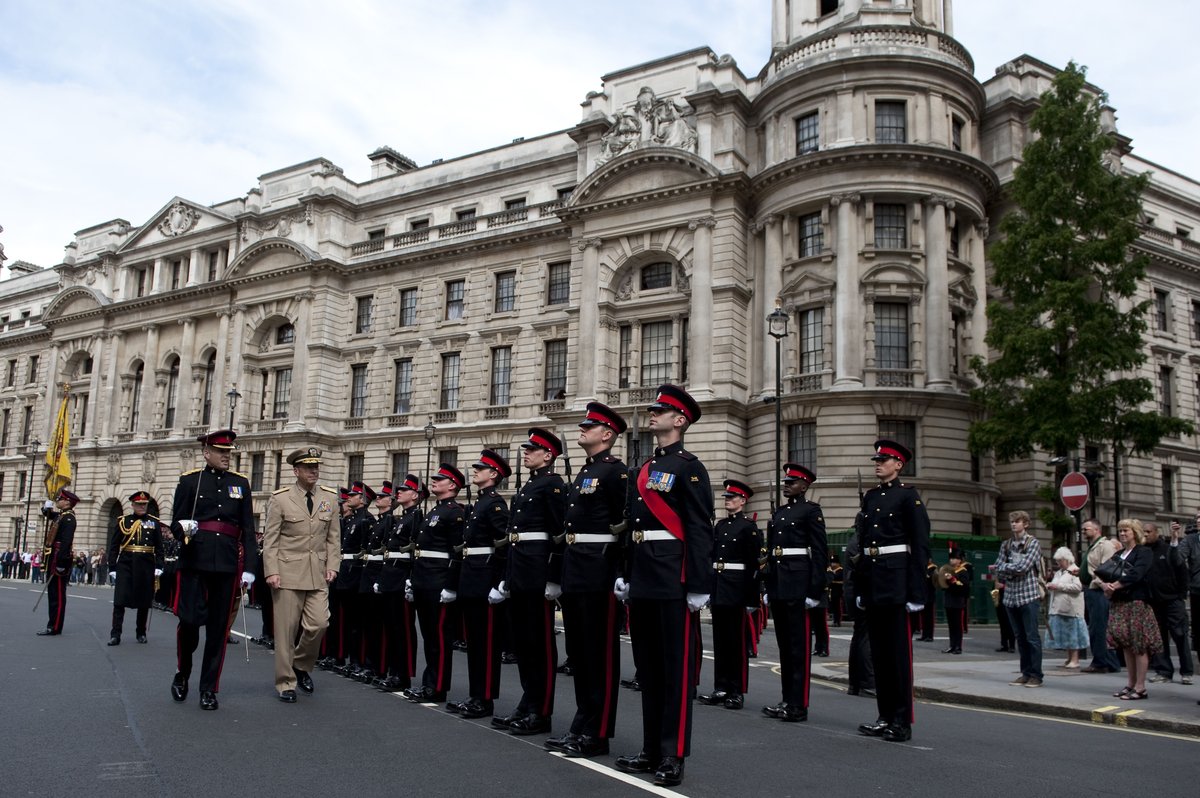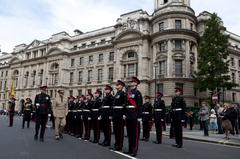
War Office London Visiting Hours, Tickets, and Historical Guide
Date: 14/06/2025
Introduction
Nestled in the heart of Whitehall, the Old War Office (OWO) stands as a monumental emblem of British military and political history. Completed in 1906 in the Edwardian Baroque style, the OWO occupies a historic site once home to the Palace of Whitehall—the principal royal residence from the 16th century until its destruction in 1698. Through centuries of royal, aristocratic, and governmental use, the OWO has borne witness to pivotal events, serving as the nerve center for the British Army during the height of the Empire and both World Wars. Today, following a meticulous restoration, the OWO is open to the public as a vibrant destination blending heritage, luxury, and immersive experiences (The OWO Official Site; BBC News; ArchDaily; CNN).
This comprehensive guide details everything you need to plan your visit: from historical context and architectural highlights to ticket information, accessibility, and nearby attractions.
Contents
- Historical Overview
- Early Origins and the Royal Legacy
- The Evolution of the War Office
- Construction and Features of the Old War Office
- Military and Political Significance
- Espionage and Cultural Impact
- The War Office in World War II and Beyond
- Visiting Information
- Visiting Hours and Ticketing
- Tours, Events, and Experiences
- Accessibility and Amenities
- Travel Tips and Nearby Attractions
- FAQs
- Practical Information and Tips
- Conclusion
- Sources
Historical Overview
Early Origins and Royal Legacy
The site of the OWO traces its roots to the 13th century as York Place, the London residence of the Archbishops of York. In the early 16th century, Cardinal Wolsey’s fall led Henry VIII to acquire the property, transforming it into the Palace of Whitehall, the main royal residence until a fire in 1698 (Smithsonian Magazine). After the fire, aristocratic houses replaced the palace, including Winchester House, which subsequently became the War Office headquarters (BBC).
Evolution of the War Office
The War Office emerged as a key governmental department in the 17th century during the English Civil War. The position of ‘Secretary at War’ was established in 1645, and the term ‘War Office’ entered official use by 1694 (Living London History). After moving between several locations, the need for a purpose-built headquarters led to the selection of the Whitehall site in 1896.
Construction and Architectural Features
Designed by William Young and completed by his son, Clyde Young, the OWO was constructed between 1899 and 1906 at a cost of £1.2 million, equivalent to over £130 million today (History Tools). The building features an impressive Portland stone façade, 1,000 rooms, 2.5 miles of corridors, grand staircases, domed turrets, and detailed sculptures by Alfred Drury (The OWO Official Site; ArchDaily). Its monumental scale reflected the power and reach of the British Empire.
Military and Political Significance
From its opening, the OWO served as the administrative and strategic heart of the British Army, playing a critical role during both World Wars. Key figures including Lord Kitchener, Winston Churchill, Herbert Asquith, and David Lloyd George worked within its walls (Country & Town House). The building’s corridors facilitated decisions that shaped global events, and its operations continued until the Ministry of Defence consolidated in 1964 (Living London History).
Espionage and Cultural Impact
The OWO’s labyrinthine corridors became synonymous with British intelligence. Naval Intelligence Officer Ian Fleming, creator of James Bond, drew inspiration from the building and its secretive atmosphere (AD Middle East). Its rooftop and interior have featured in several Bond films, further embedding it in the cultural imagination (WalkMeBlog).
The War Office in World War II and Beyond
During WWII, the OWO was central to Britain’s war effort, working closely with the nearby Cabinet War Rooms, which provided a secure underground command center for Churchill and his cabinet (Slow Travel UK). The OWO continued to serve the Ministry of Defence until 2016.
Visiting Information
Visiting Hours and Ticketing
- General Public Access: The OWO is now open to the public as part of the Raffles London at The OWO complex. Most public areas are accessible daily from 9:00 AM to 10:00 PM; however, access to historic rooms and tours is subject to specific hours and booking (Raffles London).
- Heritage Tours: Guided heritage tours are offered on select days, often during events such as Open House London. These tours typically run 10:00 AM to 5:00 PM; check the OWO Experiences page for current schedules and ticket availability.
- Tickets: Advance booking is essential for tours and special events. Tickets can be reserved online through the official OWO website or Raffles London.
Tours, Events, and Experiences
- Guided Tours: “If These Walls Could Whisper” tours take visitors through historic spaces, exploring the building’s role in world events and its architectural highlights.
- Dining and Afternoon Tea: Visitors can book dining experiences in one of the OWO’s nine restaurants or enjoy afternoon tea in the Drawing Room (Raffles London).
- Spa and Wellness: The Guerlain Spa at The OWO welcomes both hotel guests and external visitors.
- Events: The OWO hosts historical talks, exhibitions, and cultural evenings throughout the year (ArchDaily).
Accessibility and Amenities
- Wheelchair Access: The OWO offers step-free access, lifts, and accessible restrooms throughout public areas. Wheelchair users are advised to notify staff ahead to ensure the best experience.
- Assistance: Trained staff are available to assist visitors with disabilities, and assistance dogs are welcome.
- Security: Expect bag checks and possible ID verification as part of ongoing security measures (Raffles London).
Travel Tips and Nearby Attractions
- Location: The OWO is located at Whitehall, London SW1A 2BX (Google Maps).
- Getting There: Easily reached via Westminster, Charing Cross, or Embankment Underground stations (within a 5–10 minute walk). Multiple bus routes serve Whitehall and Parliament Square.
- Nearby Sights: Buckingham Palace, Downing Street, St. James’s Park, Churchill War Rooms, Trafalgar Square, and the Houses of Parliament are all within walking distance.
- Visitor Tips: Comfortable footwear is recommended due to the building’s size. Dress smart-casual, especially for dining. Book in advance to ensure access to tours or restaurants.
Frequently Asked Questions (FAQ)
What are the Old War Office visiting hours?
Public areas are open daily, typically from 9:00 AM to 10:00 PM. Heritage tours are held on select days; check the official website for current schedules.
How do I book tickets?
Book online through the OWO Experiences page or the Raffles London website. Advance booking is strongly recommended.
Is the OWO wheelchair accessible?
Yes, with step-free access, lifts, and accessible restrooms. Notify staff in advance if you require special assistance.
Can I visit without a tour?
Public access to historic areas is primarily through guided tours. Hotel, dining, and spa experiences are open to guests and external visitors with a reservation.
Is photography allowed?
Photography is permitted in most public areas; certain heritage spaces may have restrictions.
Are guided tours available?
Yes, “If These Walls Could Whisper” tours and other special programs are offered—book ahead due to limited availability.
What security measures should I expect?
Bag checks and ID verification may be in place. Large bags and certain items may be prohibited.
Practical Information and Tips
- Contact: +44 20 3907 7500 or [email protected] (Raffles London)
- Wi-Fi: Complimentary for hotel and restaurant guests; inquire for tour access.
- Cloakrooms: Facilities available for guests; check in advance for tour visitors.
- Dress Code: Smart casual recommended; formal attire for special events.
- Sustainability: The OWO is committed to environmental initiatives, including food waste reduction and partnerships with local sustainability trusts (Raffles London).
Conclusion
The Old War Office is a landmark where British history, architectural grandeur, and modern luxury converge. Its transformation from the heart of military administration to a world-class destination offers a rare opportunity for visitors to explore its storied past—whether through guided tours, fine dining, or cultural events. With its central location and accessibility, the OWO is an essential stop for anyone interested in London’s heritage.
Plan ahead, secure your tickets, and immerse yourself in this iconic site. For the latest updates, download the Audiala app, follow the OWO on social media, and check the official website for new events and offers.
Sources
- The OWO Official Site
- ArchDaily
- BBC News
- The OWO Experiences
- Smithsonian Magazine
- CNN Travel
- Living London History
- Country & Town House
- History Tools
- AD Middle East
- WalkMeBlog
- Slow Travel UK
- Raffles London
- Google Maps
- Luxury London
- London Accessibility Guide




















































































































































































































































